Detroit is a powerful and visceral piece of cinema, one that loses its way in a muddled second act.
The Hurt Locker and Zero Dark Thirty cemented Kathryn Bigalow’s talent for conveying a sense of chaos and disorganisation on film. It can be very difficult to capture the messiness of real life in the movies, given how cluttered narratives can become distracting or disorienting. It takes a very real talent to guide the audience through this carnage in a way that captures the organic ambiguities of the story while ensuring that nobody is lost or distracted. Bigalow has a very rare talent for that.

Insecurity guard.
Unsurprisingly, Detroit works best in its opening and closing acts, when the narrative pulls back to the real-life story covering the Detroit Riots in late July 1967. The film’s opening and closing beats have the feel of a weird docudrama, with Bigalow using handheld cameras and tight focus in a way that allows her to blend footage of the cast with archive material. Characters are identified by legends down the bottom of the screen, while the audience is frequently put in the position of confused spectators in a way that captures the mere anarchy loosed upon the city.
However, Detroit fumbles a little bit in its second act. For the middle of the film, Detroit narrows its focus significantly. Instead of providing socio-economic and political context for the entire riots, or dealing with the aftermath of horrific events, Detroit transforms into a story about a bunch of characters locked in a confined space together. As the film’s closing text admits, these sequences are much less verifiable than the snapshots populating the opening and closing acts, much less a matter of public record.

Big Mackie.
The second act of Detroit is a more conventional fictional narrative. While the movie is never less than interesting and clever, that organic sensibility is lost. During the first and third acts, the focus is on the broader story of the larger community, so it does not matter that many of these characters feel like archetypes and ciphers. When Detroit zooms in on the characters, they seem drawn too crudely to support the scrutiny. Detroit works a lot better as an epic social study, and less well as a claustrophobic character study.
Bigalow struggles to get the balance right, resulting in a film that is certainly ambitious and worthy, but also more uneven than her recent output. Detroit is too confident and too professional to be deemed a failure, but its second act is too shallow to be a success either.

I predict a riot.
It could reasonably be argued that Bigalow has successfully reinvented herself as a great modern war movie director. In many ways, this tends to suit her sensibilities. Wars are messy and sprawling and disorienting, and Bigalow has always had a knack for capturing that sensibility on screen in a way that is accessible to audiences. Although obviously set in the United States during the sixties, Detroit feels very much like an extension of the work that Bigalow has done in The Hurt Locker and Zero Dark Thirty.
To be fair, Detroit invites these similarities. Archive news footage suggests that the riots have turned Detroit into “a study in warfare” and that the violence has made large portions of the city “a no man’s land.” As police officers patrol the neighbourhood, one reflects, “It’s like the f$&king Nam.” The movie is populated with references to that conflict. The opening scene unfolds at a social club celebrating the return of an African American veteran from Vietnam. When the situation escalates in the Algiers Hotel, one character is a veteran of the airborne division.
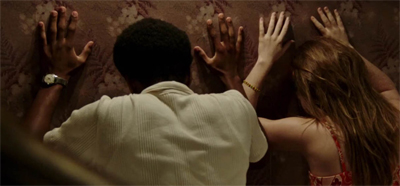
Up against the wall.
However, Detroit embraces the war genre in more than just dialogue and character. The visual language of Detroit is not too far removed from Bigalow’s recent films. The riots threaten to tear the city apart. The ruins of buildings and the remains of burnt-out cars are scattered across the landscape. By night, there is always the ominous yellow or orange glow of fire and smoke creates a shroud that might conceal all sorts of horrors. Gunshots echo in the background, while characters scramble for cover in the confusion.
The eponymous city becomes a war zone. The National Guard sweeps in to assist the besieged police force. In the real world, President Lyndon B. Johnson would also order paratroopers to help keep order in Detroit. Soldiers dressed in fatigues and carrying bayonets move through the city in armoured personnel carriers. Characters dash between cover for fear of sniper fire. The institutions of government seem on the verge of collapse. It is very powerful stuff.
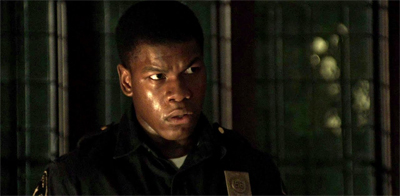
Very guarded.
Detroit works best in its opening scenes when it captures a sense of this urban chaos. It illustrates how events spiral out of control, from one late night arrest that leads to protests, that leads to looting, that leads to more violence. Writer Mark Boal is very careful in how he conveys information to the audience, both in terms of history and in terms of storytelling. Characters are introduced more as functions, actors in this grand sweeping narrative more than characters with agency.
Bigalow’s style complements Boal’s script. Although a lot of camera work is handheld to capture the sense of being off-balance, Bigalow is very meticulous in what she shows and how she guides the audience’s eye. One nice sequence follows the first rock to have been thrown during the riot. The camera watches as an angry local picks it up, unaware of the import of his actions. Then the sequence shows that rock smashing the window. Detroit creates a sense that these characters are caught in a chain of events beyond any individual’s control.
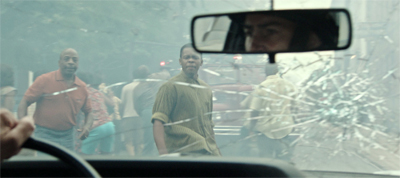
Shattered.
The movie even opens with a nice and brief animated segment that offers a refresher course on race relations in the United States in the fifty years leading up to the riots. These watercolour sequences explain concepts like mass migration and white flight, presenting a sense of the social and political factors that conspired to turn the eponymous city into a powder keg where one rock picked up by one person and thrown through one window might cause the entire system to collapse.
Detroit feels very well-observed. Despite its scale, the movie demonstrates an incredibly attention to detail, often suggesting a lot through small details about the world in which its characters live. There are furnishings wrapped in plastic, a nice and informative detail about one particular family. One interrogation room also has a rather ominous stain at about head level. These details are never articulated or explained, instead presented as elements that enrich the world. It is powerful stuff. Bigalow and Boal do great work.
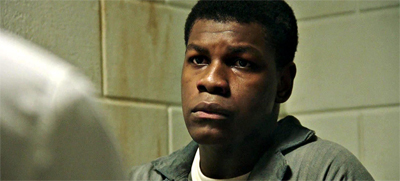
Intero-great.
However, part of the nature of this storytelling style is that none of the characters have any real depth or development. This is not a problem in the context of these early sequences, where the characters only really exist to be slotted into various roles and to complete various beats. All the audience needs to know about Officer Phillip Krauss in these opening scenes is that the character feels under siege and is driven by a desire to enforce some sense of social order upon the anarchy around him.
However, problems develop during the second act. Detroit‘s opening act focuses on the riots, but the second act shifts its focus to one particular atrocity. The middle section of Detroit is devoted to a brutal police siege of the Algiers Hotel. The movie transitions from a war film to a survival horror. The police officers become monsters, whole the hotel guests find themselves trying to live through the night. It is an interesting genre shift of itself, but it is ill-suited to the storytelling strengths of Bigalow and Boal.

Not a man you want to Krauss.
Detroit is beautifully and meticulously researched. This is obvious in how carefully the film blends archive footage and reports to its recreations. There are countless little details that populate Detroit, making the world seem lived-in and real. In particular, the camera pays attention to a lot of the “Soul Brother” graffiti that was used in a (mostly failed) attempt to dissuade the riots from damaging property owned by African Americans. However, Detroit reaches the limits of this style when it has to go beyond the official record.
To be fair, the horror depicted in the middle section of Detroit are clearly inspired by real events. They are stitched together from the testimony of various witnesses, and through careful investigation and inquiry. However, the nature of the events, and the fog that descended in their aftermath, means that the siege at the Algiers Hotel can never evoke the same legitimacy as the opening or closing acts. The middle section of Detroit ceases to be a docudrama and becomes a more conventional film.
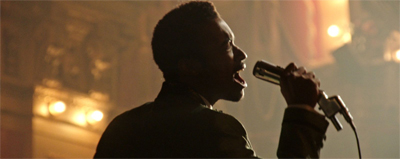
Not everything works in harmony.
However, Detroit seems rather disinterested in the demands of a more conventional linear character-focused drama. None of the characters in Detroit feel like fully-formed people, which becomes an issue when the script decides to lock them all in a confined space together. Indeed, there are several points in Detroit when it seems like characters are broadly drawn caricatures rather than individuals. This is particularly true of the cops. Phillip Krauss is out of his depth, Flynn is a stock sixties racist, Demens seems like a character who could use a more remedial education.
To be fair, there are dynamics within Detroit that work very well. In particular, John Boyega does excellent work as Dismukes, the African American security guard who gets caught up in events and trapped between the police and the community which they are vowed to protect. More than that, one of the stronger aspects of Detroit is the way in which the script understands the important of passive non-intervention in aiding and systematic oppression by those in authority.

Unfair cop.
Repeatedly, characters refuse to intervene in affairs being handled by the Detroit Police Department, and the consequences are horrific. Inaction is presented as an enabling decision. While Detroit might struggle to understand its individual characters, it has a much firm grasp of how institutions work. There are any number of moments in Detroit when outside characters could step in to prevent the situation from escalating, but instead recuse themselves. In many ways, what happens outside the Algiers Hotel is more interesting than what happens within.
Detroit is a film that works much better in broad strokes than in the finer detail. It is much more interested in systems than in individuals, much more engaged with process than with individual agency. Even the movie’s recurring metaphors enforce the sense that individual characters are largely irrelevant. Early in the film, the game of “Life” is featured prominently at the start of the looting. Later in the film, characters discuss “the so-called game of death” as a counterpoint. There is a sense that characters are simply moving in patterns and prescribed directions.

The (Det)roit Stuff.
Detroit is a clever and insightful piece of work, that beautifully captures the chaos of the eponymous events. However, it stumbles a little bits when it decides to narrow its focus to a much tighter narrative populated by fairly simple characters. Detroit is the story of city, even if it seems to forget that for extended sections of the film.
Filed under: Non-Review Reviews | Tagged: Detroit, film, kathryn bigalow, Movie, non-review review, review |




















Leave a comment